The Best Ice Climbing Gear of 2024
This article originally appeared on Outside
Apparently 2024 is the year of apparel, as most new ice climbing releases this year fell into that category. Most brands source the same or similar fabrics for alpine sports, so the true differentiator comes down to how the designers tie them all together with a fit suitable for sport--not just photo shoots. While we appreciate (and hope for) disruptors, it's no surprise that the big name brands with the most experienced athletes are the ones best linking pattern table to vertical escarpment. Below are our favorite picks of the year.
The Winners at a Glance
Arc'teryx Alpha Hybrid Pant
Arc'teryx Alpha Lightweight Parka
Grivel G20+ EVO Crampon
Patagonia Nano-Air Light Vest
Rab Ascendor Summit Hoody FZ
Mountain Hardwear Phantom Belay Down Parka
The Reviews: The Best Ice Climbing Gear of 2024
Arc'teryx Alpha Hybrid Pant ($350)
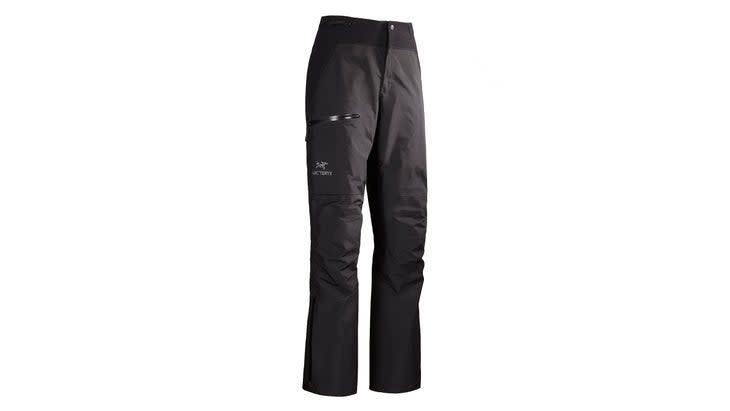
Weight: 475 g (men’s) / 400 g (women's 4R)
Size: XSR-2XLR (men's) / 0R-16R (women's)
Materials: N80D Most Rugged 3L Gore-Tex Pro, Burly Double Weave Softshell
Fit: Trim
Pros: Ultimate quiver-of-one winter pant, Highly breathable composite construction, Removable knee pads
Cons: Not fully waterproof
The Alpha Hybrid Pant has been revived since the original version, the Alpha Comp, was dropped from Arc'teryx's lineup years ago. The original pant combined hardshell Gore-Tex front and lower panels with softshell in the rear for an unmatched synthesis of weather-proofing, breathability, and movement. Unfortunately, the Alpha Comp was ultimately dropped. The athlete team nearly revolted upon the news, and has been pushing ever since for a revival.
Enter the Alpha Hybrid: an updated version with improved features like removable knee pads and a cinchable waist belt (the previous hook and loop adjustment waist had a knack for undoing itself and unintentionally hooking onto other things). While seemingly hokey, the thin, lightweight foam knee pads are never in the way but often appreciated when pulling bulges, resting knees against the wall in semi hanging belays, and the occasional knee whack that none of us are too experienced to avoid. The Hybrid retains the Alpha Comp's key crossover element: cuffs with a zipper that widen to accommodate ski boots or slim down to stay svelte on a mountain boot and avoid crampon catches. This simple adaptation is surprisingly rare, and a top reason the Alpha Hybrid is a true quiver-killer. The Gore-Tex and softshell combo also does a remarkable job of venting moisture and kept our tester's trunks dry even on a long, early summer aerobic approach in Rocky Mountain National Park. Note: the softshell rear is not waterproof, so these pants are best for cold-weather pursuits where liquid precipitation is unlikely.
Bottom line: The Alpha Hybrid is made for the cold-weather athlete who only wants to pack one pair of pants
Arcteryx Alpha Lightweight Parka ($800)
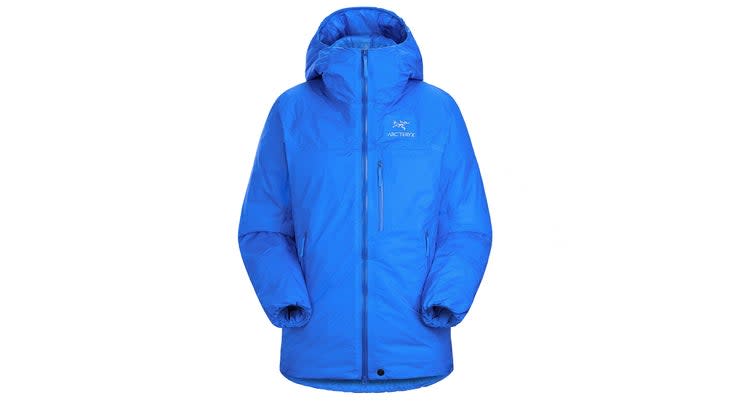
Weight: 17.3 oz (men's) / 15.9 oz (women's)
Size: XS-2XL (men's) / 2XS-2XL (women's)
Materials: 850 RDS fill down, Gore-Tex Infinium shell with Hadron face fabric
Fit: Regular
Pros: You get the warmth-to-weight benefits of down with the protection of Gore-Tex
Cons: Expensive--like, really expensive
We originally tested the Alpha Parka (not the lightweight version), and found it to be more jacket than most users would need for anything in the Lower 48, especially considering the $1,000 price tag. The Alpha Lightweight Parka chops 10 ounces and $200, retaining the premium 850 fill power and Gore-Tex Infinium shell, to give us the best belay parka we have ever used. It's packable, lightweight, and weather proof--so much so that it completely alleviated our hesitance to bring a down jacket on a mission (since down is ineffective when wet). Though a bulky belay parka, its thoughtful cut was remarkably unobtrusive when we wore it while seconding frigid WI4 pitches in Cody, Wyoming. Smart design details like dump pockets and a perfectly articulated hood that accommodates a helmet without limiting mobility are the finishing touches that seal the deal. For any adventure short of Himalayan high peaks, the Alpha Lightweight is a standout that fully justifies its high price tag. For everyday cragging, you don't need something this spendy, but as you build into multipitch mountain endeavors where every ounce counts, the Alpha Lightweight Parka is the unparalleled choice of the category.
Bottom line: The best belay parka (ever) for winter climbers who can spare some expense.
Grivel G20+ EVO Crampon ($250)
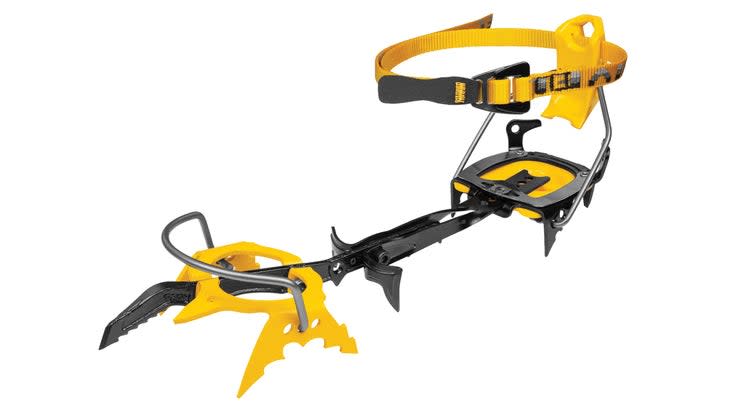
Weight: 844 g/pair
Size: one size fits all
Pros: Lightweight; Replaceable front point
Cons: Doesn't collapse as compactly as other crampons in its class; Not modular (i.e. is a dedicated monopoint)
Much like the 2006 World Cup season, the sharp-and-pointies category of ice climbing has been a back and forth showdown between French and Italian brands for decades. Thanks to its innovative design, the G20 by Italian company Grivel has upset our tester's previous French loyalties. The standout feature is the single frontpoint, extending like a velociraptor claw and forming the very frame of the crampon itself. Typically, crampon frontpoints are attached to the frame, but testers found that this unique approach worked to make the G20 lighter than rivals and very responsive--like an ergonomic extension of our feet. The razor sharp appendage sliced through waterfall ice on Vail, Colorado's classic The Fang (WI5) without shattering delicate placements. The small, horizontal secondary point was the coup de grace, as it provided security and balance for ice placements, but is recessed enough not to hinder rock placements (other designs integrating this combination struggled to strike such a balance). The only two critiques: adjustments require actual Allen key disassembly, and the single rail frame design folds in half instead of collapsing down, which makes for a slightly bulkier and awkward package to carry when not in use.
Bottom line: Crampons for ice, mixed, and alpine climbers looking for top-of-the-line performance on steep terrain.
Patagonia Nano-Air Light Vest ($199)

Weight: 7.5 oz (men's) / 6 oz (women's)
Size: XS-2XL (men's) / XS-2XL (women's)
Fit: Trim
Pros: Incomparable warmth-to-weight ratio
Cons: None really
Comedian Demetri Martin said: "Vests are all about protection. A lifevest protects you from drowning, a bulletproof vest protects you from getting shot, and a sweater vest protects you from pretty girls." Perhaps this classic 90s fashion precept is why it took our tester so long to get on board with the Nano-Air Light, but after taking it out once, he'll be riding the vest train until the end of the line. At seven ounces, this vest weighs next to nothing and adds a remarkable amount of breathable warmth to our daily kit. Our tester found the vest really shined when leading the seasonally dry, scrappy Hessie Chimney (M5) in the Indian Peaks Wilderness of Colorado, where it kept him warm in the cold temps but offered freedom of movement for the athletic stemming, arm barring, and dry tooling involved. Other puffy vests can feel bulky and too warm, but the trimmed down Nano-Air Light is barely noticeable in its volume and added just the right amount of insulation to keep us warm without overheating.
Bottom line: Keep your core warm without cluttering your arms.
Rab Ascendor Summit Hoody FZ ($200)
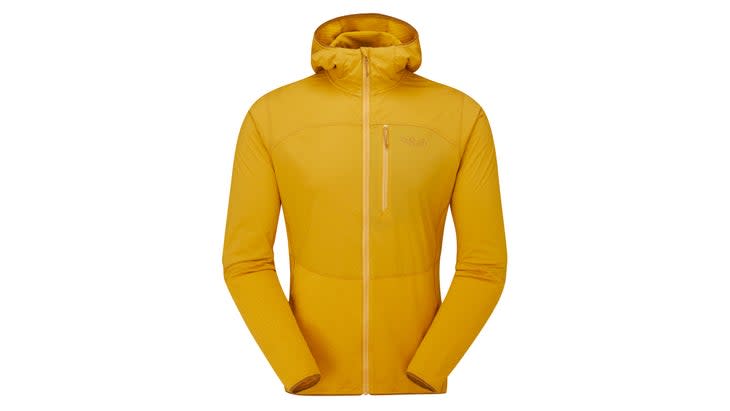
Weight: 11.6 oz (men's) / 9.8 oz (women's)
Size: S-XXL (men's) / XS-XL (women's)
Fit: Slim
Pros: Simple, well executed midlayer
Cons: Shockingly, none
We often hear the design phrase, "simplest is the most difficult," but in this case, Rab nailed it. It isn't fancy, but it has all the technical characteristics you need, with nothing else (similarly to an iconic fan-favorite, the Patagonia R1 Fleece Pullover. Key features that make this hoody standout are the athletic cut, no superfluous bells or whistles, a smooth outer face, and a well-fitting hood. There is no bulky material around the arms or midsection, and simple but thoughtful features like hidden thumb loops and smooth outer lining across the shoulders shed moisture. If your layering system calls for a mid-weight fleece layer, this is your pick.
Bottom line: A no frills, well designed mid-layer
Mountain Hardwear Phantom Belay Down Parka ($550)
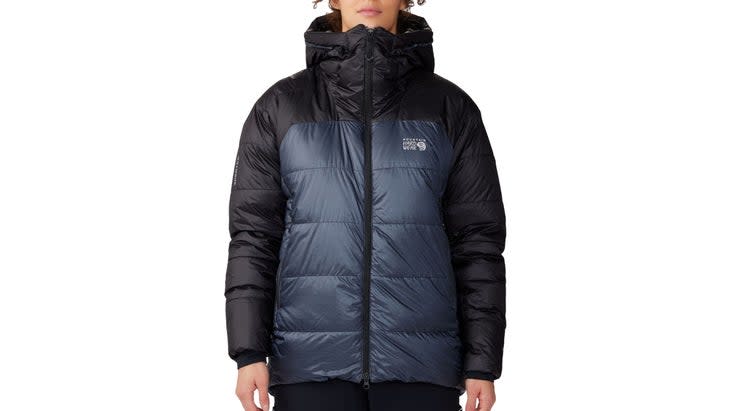
Weight: 27 oz
Size: S-2XL
Materials: 800 fill down, Pertex Quantum Diamond Fuse 20D Ripstop shell’
Fit: Regular/Generous
Pros: Weather protected down warmth
Cons: On the bulkier and heavier side
If the Arc'teryx Alpha Lite is the Porsche of belay parkas (beautiful, trim lines and high end without an extra ounce), then the Phantom is the Cadillac: roomy, comfortable, plenty of performance capabilities for the majority of us, and more affordable. The ripstop Pertex shell that protects the moisture-sensitive down fill was completely bomber in its performance, so we had peace of mind when scraping it against rocks and boulders. The bulky cut and fill are more suited for belays than active movement, but for hunkering down and staying toasty, this parka is tough to beat. Plus, the generous baffling and fill are akin to being wrapped in a cloud during basecamp lounging.
Bottom line: A solidly priced, quality down jacket that's sure to last
How to Buy
Ice climbing is the most gear intensive, and therefore expensive, iteration of climbing. With that comes an allure to buy everything – but any ice climbing kit is holistic and needs to all work well together. A single standout piece of apparel is worthless if it doesn't combine well with the rest of your action suit. Colin Haley has a great article about layering for alpine climbing, in which he aptly observes, "At any given moment in time, I must be able to wear every item of clothing that I brought with me on a climb (the exceptions to this rule are gloves and socks)." Make sure everything can be functionally worn together, and try items on as you will use them. For example, if you'll be wearing baselayers then try on prospective pants with a baselayer underneath to make sure they allow the mobility you'll want and need in the mountains.
If you're starting out, we recommend being conservative on how much you spend before you know exactly what you're looking for--much like a $200 pair of rock shoes is unnecessary for a beginner. And unless you are certain you want to focus on a hyper specific niche of the sport, look for the most generalist items within a category, what we like to call "quiver killers." For example, we loved the G20 Plus Crampons for steep vertical ice and mixed, but if you're starting out with more moderate grades, they'd be a poor choice and unnecessarily costly. Secondhand gear will give you a feel for the sport and your preferences before you throw down thousands on a fancy new kit. Check out online forums like MountainProject.com and eBay, or even your local Facebook Marketplace.
For those ready to dive in on new gear, boots are a number one spending priority. Take care of your feet--you can't get anywhere without them. Most modern tools and crampons will last for years, which means used pairs perform like new with a fresh set of picks or frontpoints. But boots wear out and a nice, new pair suited to your fit will deliver the most bang-for-your-buck. Head to a local shop that knows the sport to get a well-fitting pair, and repay their expertise with a purchase. From there you can begin to accumulate hard goods like ice tools, crampons, and ice screws. Most ropes, draws, and harnesses can cover the gamut from rock to ice if purchased with versatility in mind.
How We Test
Number of testers: 6
Number of products tested: 75
Number of miles/vertical feet: tens of 1000s
Socrates said the wisest man knows he knows nothing, so our lead tester leaned on a list of climbers he looks up to, ranging from Cody, WY, ice climbing guide Dane Steadman to alpine legend Bruce Miller (a man who saved Steve House's life, not once, but twice). This year’s collection of products got wrung through the paces from Colorado to Alaska--including the coveted Jeff Lowe & Will Gadd testpiece Deep Throat (M7 WI6) in Glenwood Canyon, CO.
Meet Our Lead Tester
Maury Birdwell
Maury is an attorney and climber based in Boulder, CO. He has had the good fortune to climb and establish routes around the world, his favorite part of which is the communion it provides with his partners and the heroes who came before him. Some highlights include freeing the original Royal Robbins line on Mount Hooker in the Wind River Range with Jesse Huey (Original Sin, 5.12+), the first free ascent of Armageddon (5.12+) on the North Howser Tower in the Bugaboos, Canada, and setting the car-to-car speed record for climbing (solo) the Diamond of Longs Peak. His work focuses on outdoor business development, and in 2012 he co-founded the Honnold Foundation with Alex Honnold - perhaps his greatest personal 'send' to date.
For exclusive access to all of our fitness, gear, adventure, and travel stories, plus discounts on trips, events, and gear, sign up for Outside+ today.

